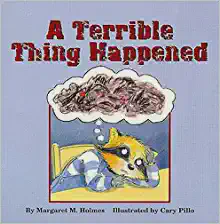A Terrible Thing Happened

Recommended Age Range: Best for kids in preschool and early- to mid-elementary school, but it’s still a good fit for a developmentally younger and/or more emotionally distressed 8- or 9-year-old who would benefit from a simple, calm introduction to trauma and therapy.
Publisher's Summary:
“Sherman Smith saw the most terrible thing happen. At first he tried to forget about it, but soon something inside him started to bother him. He felt nervous for no reason. Sometimes his stomach hurt. He had bad dreams. And he started to feel angry and do mean things, which got him in trouble. Then he met Ms. Maple, who helped him talk about the terrible thing that he had tried to forget. Now Sherman is feeling much better.”

Dr. Annie's Takeaways
Recommended for: This book is great for caregivers to read with a child prior to starting therapy or for a therapist to read with a client prior to starting trauma treatment. It really pulls for the child to share their story, so if a parent might be triggered by this (i.e., if a parent also experienced the frightening event and is going through their own trauma process), I’d recommend using this book as a set-up for therapy, rather than an at-home intervention. It is best for children who witnessed a specific frightening event (e.g., a car crash, domestic violence, a hate crime) rather than multiple, complex traumas.
Would a child like it? Many children who witnessed a terrible thing would find this story reassuring and compelling, particularly if it’s followed up with an opportunity to draw their own feelings and experiences. It’s a bit understated, which is often good for a child who may be surrounded by adults who are expressing intense emotions, and it provides a pathway to feeling better, which might be a very welcome source of hope for a struggling child.
Evidence-Based Practices:
Cognitive restructuring
Tone: Serious, matter-of-fact, reassuring
Story Quality: A child who has witnessed “a terrible thing” will immediately recognize themselves in this story and would likely find the story validating and comforting, if not particularly captivating as a standalone narrative. It’s intentionally vague so that a child can project their own experience onto the story, which I think was the right decision for this book, but also makes the story a little less vivid on its own. The language is simple, clear, and very developmentally appropriate. There are no confusing euphemisms or nods to adults, which makes it a very safe-feeling book–an important quality for a book on this topic.
Illustrations: Sweet watercolor drawings of woodland creatures doing human things (Sherman is a racoon, Ms. Maple is a bear, and Sherman’s friends are a bunny and a squirrel).
Representation: The characters in this story are woodland animals, rather than humans. Sherman is represented as a male raccoon. Sherman lives in a suburban neighborhood (there’s an illustration with a single family house and a white picket fence), and he has a sister and a dog. Very little else is described about Sherman and his friends and family.
Psychological Practices: Helps children and caregivers connect feelings (e.g., stomachaches, feeling sad) and behaviors (e.g., being “mean” at school, hyperactivity) with children’s experience of witnessing something frightening. Provides a friendly overview of what might happen in therapy and instills hope that it will help the child to feel better. Makes a nod to evidence-based practices such as a trauma narrative (Sherman draws out what happened, and he and Ms. Maple talk about it) and identifying trauma-related cognitions (Sherman says that he often thinks the “terrible thing” is his fault, and Ms. Maple reassures him that it isn’t).
Concerns: Nope
